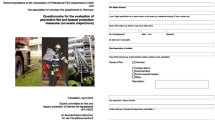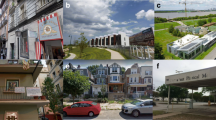Abstract
This paper examines the effect wildfire mitigation has on broad-scale wildfire behavior. Each year, hundreds of million of dollars are spent on fire suppression and fuels management applications, yet little is known, quantitatively, of the returns to these programs in terms of their impact on wildfire extent and intensity. This is especially true when considering that wildfire management influences and reacts to several, often times confounding factors, including socioeconomic characteristics, values at risk, heterogeneous landscapes, and climate. Due to the endogenous nature of suppression effort and fuels management intensity and placement with wildfire behavior, traditional regression models may prove inadequate. Instead, I examine the applicability of propensity score matching (PSM) techniques in modeling wildfire. This research makes several significant contributions including: (1) applying techniques developed in labor economics and in epidemiology to evaluate the effects of natural resource policies on landscapes, rather than on individuals; (2) providing a better understanding of the relationship between wildfire mitigation strategies and their influence on broad-scale wildfire patterns; (3) quantifying the returns to suppression and fuels management on wildfire behavior.
Similar content being viewed by others
References
Amacher GS, Malik AS, Haight RG (2005) Not getting burned: the importance of fire prevention in forest management. Land Econ 81: 284–302
Behrman JR, Cheng Y, Todd PE (2004) Evaluating preschool programs when length of exposure to the program varies: a nonparametric approach. Rev Econ Stat 86: 108–122
Bellman RE (1961) Adaptive control processes. Princeton University Press, Princeton
Brose P, Wade D (2002) Potential fire behavior in pine flatwood forests following three different fuel reduction techniques. For Ecol Manage 163: 71–84
Butry DT (2006) Estimating the efficacy of wildfire management using propensity scores. Ph.D. Dissertation, North Carolina State University, p 110
Butry DT, Mercer DE, Prestemon JP, Pye JM, Holmes TP (2001) What is the price of catastrophic wildfire?. J Forestry 99: 9–17
Butry DT, Pye JM, Prestemon JP (2002) Prescribed fire in the interface: separating the people from the trees. In: Outcalt KW (ed) Proceedings of the eleventh biennial southern silvicultural research conference. General technical report SRS-S48, Department of Agriculture, Forest Service, Southern Research Station, Asheville, pp 132–136
Cleaves DA, Martinez J, Haines TK (2000) Influences of prescribed burning activity and costs in the national forest system. General technical report SRS-S37, U.S. Department of Agriculture Forest Service
Davis LS (1965) The economics of wildfire protection with emphasis on fuel break systems. Resources Agency, Department of Conservation, Division of Forestry, Sacramento, State of California
Dehejia RH, Wahba S (1999) Causal effects in nonexperimental studies: reevaluating the evaluation of training programs. J Am Stat Assoc 94: 1053–1062
Dehejia RH, Wahba S (2002) Propensity score-matching methods for nonexperimental causal studies. Rev Econ Stat 84: 151–161
EarthInfo, Inc (2002) NCDC first order summary of the day. Data on CD
Gorte JK, Gorte RW (1979) Application of economic techniques to fire management: a status review and evaluation. General technical report INT-53, USDA Forest Service, Ogden
Greene WH (2000) Econometric analysis. Upper Saddle River, New Jersey, p 1004
Halvorsen R, Palmquist R (1980) The interpretation of dummy variables in semilogarithmic equations. Am Econ Rev 70: 474–475
Heckman JJ, Hotz VJ (1989) Choosing among alternative nonexperimental methods for estimating the impact of social programs: the case of manpower training. J Am Stat Assoc 84: 862–874
Heckman JJ, Robb R (1985) Alternative methods for evaluating the impact of interventions. In: Heckman J, Singer B(eds) Longitudinal analysis of labor market data. Cambridge University Press, New York, pp 156–246
Hirano K, Imbens GW (2004) The Propensity score with continuous treatment. Draft of chapter for missing data and Bayesian methods in practice: contributions from Donald Rubin’s statistical family, Forthcoming from Wiley
Hirsch KG, Podur JJ, Janser RF, McAlpine RS, Martell DL (2004) Productivity of Ontario initial-attack fire crews: results of an expert-judgement elicitation study. Can J For Res 34: 705–715
Imai K, van Dyk DA (2004) Causal inference with general treatment regimes: generalizing the propensity score. J Am Stat Assoc 99: 854–866
Imbens GW (2004) Nonparametric estimation of average treatment effects under exogeneity: a review. Rev Econ Stat 86: 4–29
Imbens GW (2000) The role of the propensity score in estimating dose-response functions. Biometrika 87: 706–710
Joffe MM, Rosenbaum PR (1999) Propensity scores. Am J Epidemiol 150: 327–333
Kennard DK (2004) Depth of Burn. Forest Encyclopedia, Available at http://www.forestencyclopedia.net
Kennedy PE (1981) Estimation with correctly interpreted dummy variables in semilogarithmic equations. Am Econ Rev 71: 801
LaLonde R (1986) Evaluating the econometric evaluations of training programs with experimental data. Am Econ Rev 76: 604–620
Lu B, Zanutto E, Hornik R, Rosenbaum PR (2001) Matching with dose in an observational study of a media campaign against drug abuse. J Am Stat Assoc 96: 1245–1253
Mercer DE, Prestemon JP, Butry DT, Pye JM (2007) Evaluating alternative prescribed burning policies to reduce net economic damages from wildfire. Am J Agri Econ 89: 63–77
National Oceanic and Atmospheric Administration. (2002) El Niño-Southern oscillation sea surface temperature measures. Available at <ftp://ftp.ncep.noaa.gov/pub/cpc/wd52dg/data/indices/sstoi.indices>. Accessed by author on October, 2002
Outcalt KW, Wade DD (2004) Fuels management reduces tree mortality from wildfires in Southeastern United States. South J Appl Forestry 28: 28–34
Parks GM (1964) Development and application of a model for suppression of forest fires. Manage Sci 10: 760–766
Prestemon JP, Butry DT (2005) Time to burn: modeling wildland arson as an autoregressive crime function. Am J Agri Econ 87: 756–770
Prestemon JP, Mercer DE, Pye JM, Butry DT, Holmes TP, Abt KL (2001) Economically optimal wildfire intervention regimes. Paper presented at the annual meeting of the American agricultural economics association, August 5–8, 2001, Chicago, Illinois. 18 pages. Published on the Internet, <http://agecon.lib.umn.edu/cgi-bin/pdf_view.pl?paperid=2872>
Prestemon JP, Pye JM, Butry DT, Holmes TP, Mercer DE (2002) Understanding broad scale wildfire risks in a human-dominated landscape. Forest Sci 48: 685–693
Reed WJ (1987) Protecting a forest against fire: optimal protection patterns and harvest policies. Nat Res Model 2: 23–53
Rideout DB, Omi PN (1990) Alternative expressions for the economic theory of forest fire management. Forest Sci 36: 614–624
Rosenbaum PR, Rubin DB (1983) The central role of the propensity score in observational studies for causal effects. Biometrika 70: 41–55
Rosenbaum PR, Rubin DB (1985) The bias due to incomplete matching. Biometrics 41: 103–116
Rosenbaum PR, Rubin DB (1985) Constructing a control group using multivariate matched sampling methods that incorporate the propensity score. Am Stat 39: 33–38
Rubin DB (1990) Formal modes of statistical inference for causal effects. J Stat Plan Inf 25: 279–292
Rubin DB, Thomas N (2000) Combining propensity score matching with additional adjustments for prognostic covariates. J Am Stat Assoc 95: 573–585
Smith J, Todd P (2005) Does matching overcome lalonde’s critique of nonexperimental estimators. J Econ 125: 305–353
Sparhawk WN (1925) The use of liability ratings in planning forest fire protection. J Agri Res 30: 693–762
Stewart S, Radeloff V, Hammer R, Fried J, Holcomb S, McKeefry J (2005) Mapping the wildland urban interface and projecting its growth to 2030. USDA Forest Service, North Central Research Station
United States Census Bureau (2004) http://www.census.gov
Wade DD, Brock BL, Brose PH, Grace JB, Hoch GA, Patterson WA, III (2000) Chapter 4: Fire in eastern ecosystems. In: Brown JB, Smith JK (eds) Wildland fire in ecosystems: effects of fire on flora. General technical report RMRS-GTR-42-vol2. USDA Forest Service, Rocky Mountain Research Station, Ogden, p 257
Winship C, Mare RD (1992) Models for sample selection bias. Ann Rev Soc 18: 327–350
Yoder J (2004) Playing with fire: endogenous risk in resource management. Am J Agri Eco 86: 933–948
Author information
Authors and Affiliations
Corresponding author
Rights and permissions
About this article
Cite this article
Butry, D.T. Fighting fire with fire: estimating the efficacy of wildfire mitigation programs using propensity scores. Environ Ecol Stat 16, 291–319 (2009). https://doi.org/10.1007/s10651-007-0083-3
Received:
Revised:
Published:
Issue Date:
DOI: https://doi.org/10.1007/s10651-007-0083-3




